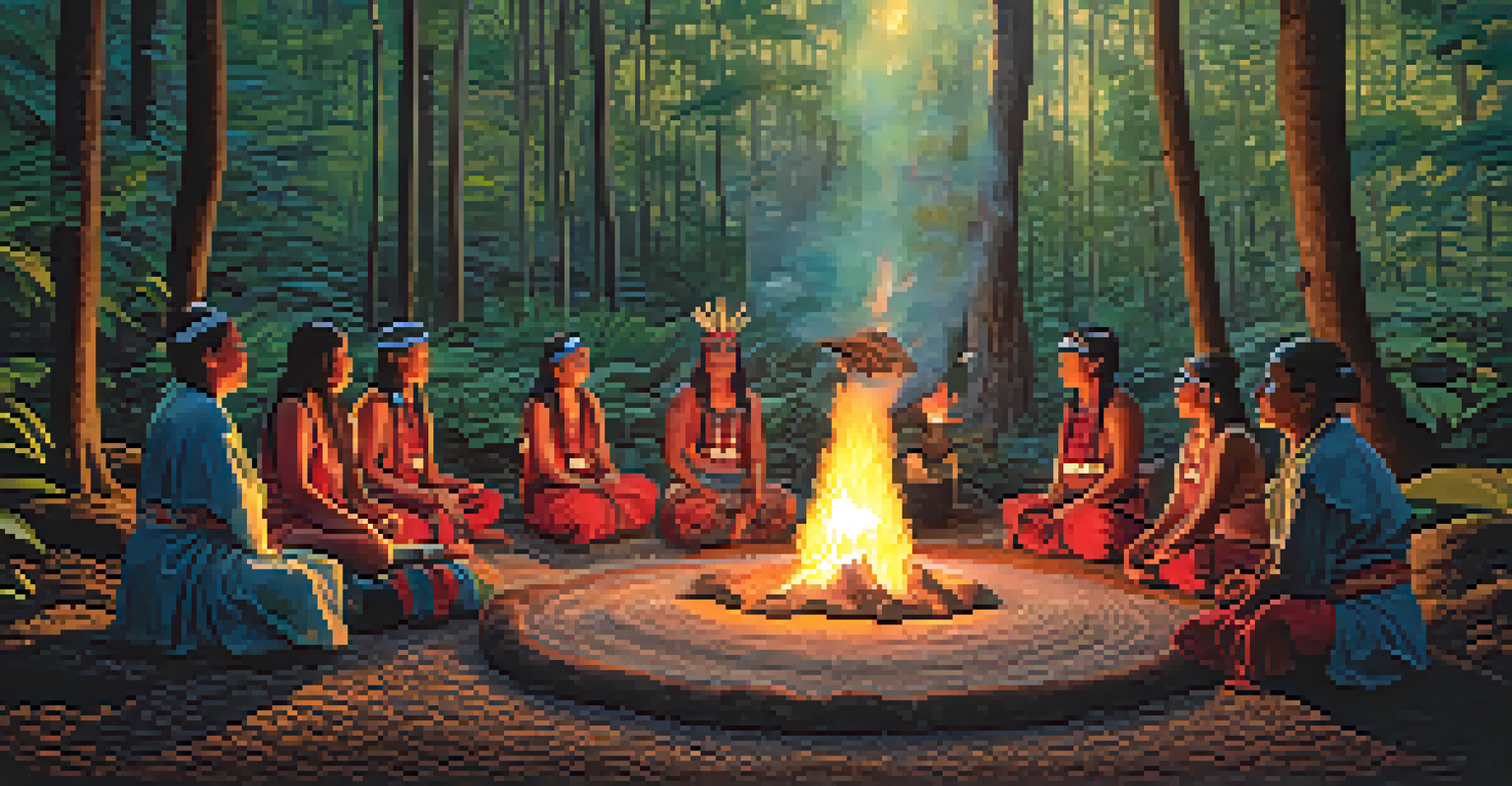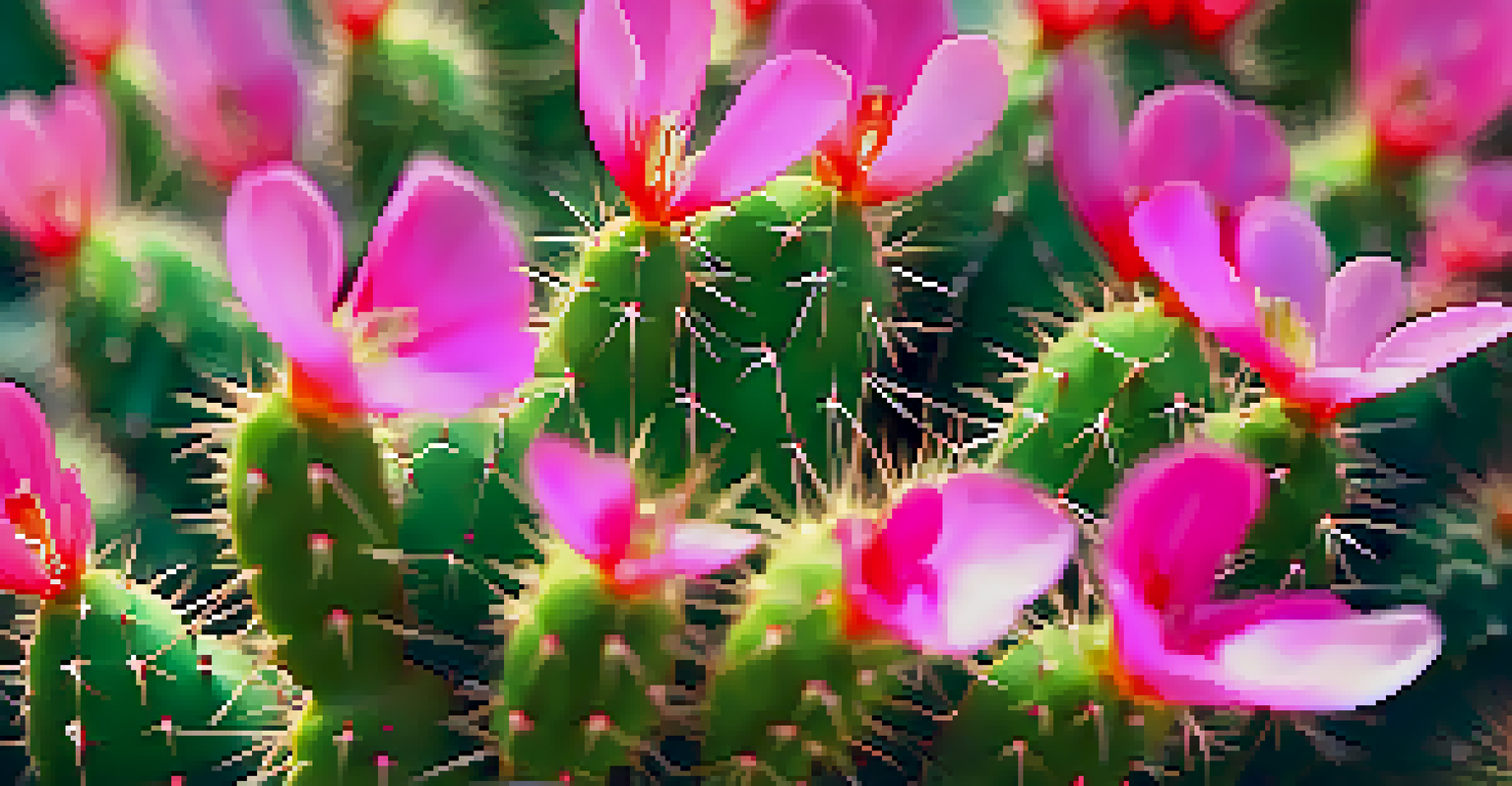Psychoactive Properties of Peyote and Healing in Indigenous Cultures

Understanding Peyote and Its Psychoactive Components
Peyote, a small cactus native to Mexico and the southwestern United States, has long fascinated both scientists and spiritual seekers. Its psychoactive properties primarily come from a compound called mescaline, which can induce vivid hallucinations and deep introspection. These effects can vary widely among individuals, leading to personal experiences that are often described as transformative.
The use of peyote is not just about the drug; it is about the journey of the spirit and the connection to the earth.
In Indigenous cultures, especially among the Native American Church and other tribes, peyote is revered not just as a drug but as a sacred gift from nature. Its use dates back thousands of years, and it plays a crucial role in various ceremonies and rituals. Here, the psychoactive experience is viewed as a pathway to connect with the spiritual realm and one's inner self.
Understanding peyote's psychoactive components is essential for appreciating its cultural significance. The combination of its chemical effects and the ritualistic context creates a unique experience that goes beyond mere intoxication, inviting participants to explore profound questions of existence and purpose.
The Role of Peyote in Healing Practices
In many Indigenous cultures, peyote is considered a powerful tool for healing, both physically and spiritually. Traditional healers often incorporate peyote into their practices to address ailments, promote mental wellness, and foster emotional healing. Participants in peyote ceremonies report feelings of catharsis, clarity, and a renewed sense of purpose.

The healing aspect of peyote is deeply intertwined with its psychoactive effects. Individuals often experience visions or insights during ceremonies that can lead to personal revelations about their life and relationships. These insights provide a framework for healing, guiding participants toward better emotional and spiritual health.
Therapeutic Potential of Mescaline
Scientific research highlights mescaline's potential in treating mental health conditions like PTSD and depression.
Moreover, the communal aspect of peyote ceremonies reinforces a sense of belonging and support among participants. Sharing experiences with others can amplify the healing process, creating an environment where individuals feel safe to explore their vulnerabilities and heal collectively.
Cultural Significance of Peyote in Indigenous Traditions
Peyote holds significant cultural importance for various Indigenous tribes, serving as a bridge between the physical and spiritual worlds. Its use is steeped in tradition, rituals, and teachings that have been passed down through generations. This cultural context enriches the experience, making it more than just a psychoactive substance.
Psychedelics, when used in the right context, can be powerful allies for healing and self-discovery.
For many tribes, the peyote ceremony is a sacred space where individuals can seek guidance, healing, and a deeper understanding of themselves and their connection to the universe. The songs, prayers, and storytelling that occur during these ceremonies serve to honor the plant and its role in their lives.
This cultural significance also extends to the preservation of Indigenous identity and spirituality. By participating in peyote rituals, individuals reaffirm their heritage and maintain a connection to their ancestors, reinforcing a sense of community and continuity.
The Science Behind Peyote and Mescaline
While much of the understanding of peyote is rooted in tradition, scientific research has begun to uncover the biological mechanisms behind its psychoactive effects. Mescaline interacts with serotonin receptors in the brain, influencing mood, perception, and cognition. This interaction can lead to altered states of consciousness and profound emotional experiences.
Studies have shown that psychedelics, including mescaline, can have therapeutic effects, particularly in treating conditions like PTSD, depression, and anxiety. The potential for peyote to aid in mental health treatment is an exciting area of research, drawing attention to its benefits beyond traditional contexts.
Challenges to Peyote Practices
Modern legal restrictions and the commodification of peyote threaten the preservation of its cultural and healing traditions.
However, it's essential to approach this research with respect for cultural practices. The scientific exploration of peyote should complement, not overshadow, the spiritual and communal experiences that Indigenous cultures have cultivated for centuries.
Challenges Facing Peyote Use in Modern Society
Despite its rich cultural heritage, the use of peyote faces numerous challenges in modern society. Legal restrictions often limit access for Indigenous peoples who wish to practice their traditions. This can lead to a disconnect between generations and the potential loss of important cultural practices.
Additionally, the increasing interest in psychedelics for recreational use raises concerns about the commodification of peyote. As more people seek out peyote experiences without understanding their cultural significance, there is a risk of undermining its sacredness and the traditions surrounding it.
Advocacy for the rights of Indigenous peoples and the protection of their cultural practices is crucial. Ensuring that peyote remains accessible for ceremonial use helps preserve its role in healing and community bonding while respecting the traditions that have sustained it for centuries.
Integrating Peyote into Contemporary Healing Practices
As interest in alternative healing methods grows, there is a conversation about integrating peyote's psychoactive properties into modern therapeutic practices. Some mental health professionals are exploring how elements of peyote ceremonies can complement traditional therapies, promoting holistic healing approaches that respect Indigenous traditions.
This integration could involve creating safe spaces for individuals to engage with their spirituality while receiving professional support. By acknowledging the wisdom of Indigenous practices, contemporary healing can become more inclusive and holistic, valuing both traditional and modern methods.
Peyote's Cultural Significance
Peyote is revered in Indigenous cultures as a sacred tool for spiritual connection and healing.
However, it's essential to approach this integration with caution and respect. Collaborating with Indigenous communities to ensure ethical practices and proper guidance is vital to maintain the integrity of peyote's cultural significance while exploring its therapeutic potential.
The Future of Peyote in Indigenous and Global Contexts
Looking ahead, the future of peyote is intertwined with the fate of Indigenous cultures and their rights. As awareness of its healing properties grows, there is hope for greater recognition of Indigenous knowledge and practices in mainstream society. This could lead to a resurgence of traditional peyote use and a deeper appreciation for its cultural significance.
On a global scale, the increasing acceptance of psychedelics for therapeutic use may open doors for Indigenous practices. This recognition could promote dialogue about the importance of preserving traditional knowledge and protecting sacred plants like peyote from exploitation.

Ultimately, the future of peyote lies in a balanced appreciation for both its cultural roots and its potential therapeutic benefits. By fostering respect and understanding between Indigenous and non-Indigenous communities, we can ensure that the healing power of peyote continues to thrive in both contexts.